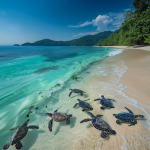In a heartwarming tale of international cooperation, Thailand is set to repatriate over 900 rare lemurs and turtles to their native habitat in Madagascar, a significant step towards combating the illegal wildlife trade. This monumental initiative is spearheaded by the Department of National Parks, Wildlife and Plant Conservation (DNP), earning plaudits from conservationists worldwide.
Leading the charge, DNP chief Attapol Charoenchansa shared the exhilarating news that 963 animals, featuring ring-tailed lemurs, brown lemurs, spider tortoises, and radiated tortoises, had been secured from the clutches of an illegal wildlife syndicate in May. These exotic creatures were seized in the picturesque province of Chumphon, following a detailed tip-off to the Natural Resources and Environmental Crime Division. This tip led to an expertly orchestrated operation that saw law enforcement establishing checkpoints along key transit routes, resulting in the apprehension of six suspects along with 1,117 animals, both alive and deceased.
This crackdown highlights the global commitment towards safeguarding threatened species, with Mr. Charoenchansa proudly stating, “This is more than just a wildlife rescue; it’s a demonstration of our dedication to eradicating wildlife crime.”
The captured animals, unique to Madagascar, include several species that are critically endangered, being listed under Annex I of the Convention on International Trade in Endangered Species (CITES). Their return to Madagascar marks a pivotal moment in wildlife preservation, underscoring the enduring power of international collaborations.
Adding a touch of ceremony to the proceedings, Madagascar’s Minister of Environment and Sustainable Development, the esteemed Max Andonirina Fontaine, has planned to personally oversee this monumental repatriation. A special send-off ceremony is slated for November 27 at the Ministry of Natural Resources and Environment. The wildlife will then soar across continents aboard three Qatar Airways flights departing on November 28, November 30, and December 2, with Mr. Fontaine himself escorting the first cohort of animals.
This operation symbolizes more than just a return to the wild for these animals; it signifies hope, resilience, and a robust stand against the forces that threaten our planet’s most vulnerable denizens. The world watches in anticipation as these creatures embark on their journey home, a testament to what can be achieved when nations unite towards a common cause. In this remarkable dance of diplomacy and determination, Thailand and Madagascar remind us all of our shared responsibility to protect Earth’s rich biodiversity, one rescue at a time.


















It’s amazing to see international cooperation at its finest! This gives me hope for the future of endangered species.
But is it really going to solve anything in the long term? These operations seem like a drop in the bucket compared to the overall illegal trade.
Maybe it’s just a drop, but it’s a start. Every effort counts, especially when it’s about preserving life.
Exactly! We can’t just ignore problems because they’re big. Step by step, operations like this pave the way for bigger changes.
I wonder how many animals die during these trafficking operations. It’s heartbreaking to even think about.
Unfortunately, the mortality rate is often high. Many animals are too fragile to survive such conditions.
Sad reality. It’s commendable though that at least this batch survived to return home.
Yay for the lemurs! I really hope that once back in Madagascar, they’ll thrive and multiply.
I don’t understand why they just don’t keep them in zoos. Isn’t it safer for critically endangered animals?
Zoos are not their natural habitat. Animals deserve to live in their real homes, not be caged for our entertainment.
Plus, living in the wild is crucial for maintaining their natural behaviors and genetic diversity.
Some zoos do play a role in conservation, but rehabilitation and release should be the ultimate goal.
It sounds like a lot of resources for just one operation. I hope this inspires other countries to take similar actions.
Resources are well spent if they help prevent extinction. Other countries can definitely learn from this.
I’m really impressed with Thailand’s initiative, but the root cause of poaching needs more attention.
Absolutely. Poverty and demand for exotic pets fuel this trade. It’s a complex issue.
Right, addressing those underlying causes could make a significant difference.
Does anyone know how effective past repatriation efforts have been? I hope this is more than a PR stunt.
Success rates vary, but they can be quite effective in replenishing wild populations when done right.
I’m just so happy these animals get a second chance. It’s what they deserve.
Can’t they use technology like drones to stop poaching before it happens? Seems logical to me.
Drones are used, but they can’t replace boots on the ground. Technology aids but doesn’t solve everything.
What’s really going to change, though? Once the media attention is gone, so is the momentum.
It’s a feel-good story, no doubt, but I hope it inspires long-term policy change.
I read this with my kids, and now they want to learn more about lemurs and turtles. This story is educational!
Can’t wait to see how Madagascar celebrates their return. It’s a cultural win too.
Madagascar has such a unique biodiversity. Hope the local communities are involved in conservation efforts.
Exactly, community involvement is key to sustainable efforts.
I’m curious about the logistics of moving so many animals. It must be a huge undertaking.
I just hope they’re being well taken care of during transportation. Animal welfare should be top priority.